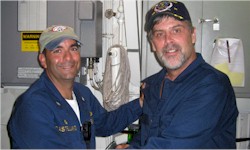Sammie
Well-Known Member
I know it's tempting to automatically give credence to something that you already want to believe, but you guys really should do some fact checking before buying into this stuff.
The first thing that should jump out at you about this article is that the author is extremely hostile to Obama, so right off the bat you know it won't be objective.
Secondly, the author does not cite a single, solitary source for any of his claims, which begs the question "How does he know all this stuff?"
The answer is, "He doesn't". Most of what he says was lifted from an anonymous email that has been circulating the web, and has already been investigated and reported on:


Maersk Alabama Capt. Richard Phillips,
right, with Cmdr. Frank Castellano of the
USS Bainbridge, after being rescued.
WASHINGTON – While Barack Obama is basking in praise for his "decisive" handling of the Somali pirate attack on a merchant ship in the Indian

Ocean, reliable military sources close to the scene are painting a much different picture of the incident – accusing the president of employing restrictive rules of engagement that actually hampered the rescue of Capt. Richard Phillips and extended the drama at sea for days.
Multiple opportunities to free the captain of the Maersk Alabama from three young pirates were missed, these sources say – all because a Navy SEAL team was not immediately ordered to the scene and then forced to operate under strict, non-lethal rules of engagement.
They say the response duty office at the Pentagon was initially unwilling to grant an order to use lethal force to rescue Phillips. They also report the White House refused to authorize deployment of a Navy SEAL team to the location for 36 hours, despite the recommendation of the on-scene commander.
The White House also turned down two rescue plans offered up by the Seal commander on the scene and the captain of the USS Bainbridge.
The SEAL team operated under rules of engagement that required them to do nothing unless the hostage's life was in "imminent' danger.
In fact, when the USS Bainbridge dispatched a rigid-hull inflatable boat to bring supplies to the Maersk Alabama, it came under fire that could not be returned even though the SEAL team had the pirates in their sights.
Many hours before the fatal shots were fired, taking out the three young pirates, Phillips jumped into the Indian Ocean with the idea of giving the snipers a clear target. However, the SEAL team was still under orders not to shoot.
Hours later, frustrated by the missed opportunities to resolve the standoff, the commander of the Bainbridge and the captain of the Navy SEAL team determined they had operational authority to evaluate the risk to the hostage, and took out the pirates at the first opportunity – finally freeing Phillips.






